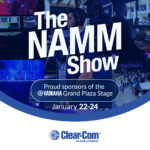During the Welcome Session at NAB Show 2023 today, NAB President and CEO Curtis LeGeyt spoke with Univision Los Angeles’ Gabriela Teissier in a fireside chat about the state of the broadcast industry.
LeGeyt discussed a wide range of topics, including:
NAB Show 2023:
“If we look around this week, we’re with tens of thousands of our closest friends here in Las Vegas celebrating the very best of broadcasting, reflecting on the last 100 years of our legacy, while at the same time positioning ourselves to innovate to be relevant to our audiences in the future. This is just such a great opportunity to connect to really celebrate the very best of what we do in communities around the country.”
The importance of keeping radio in the car dashboard:
“We as an industry have a role to play by stepping up and reminding the public and automakers of our ongoing relevance. The facts are, according to Nielsen, 82 million Americans tuned into AM radio at some point over the last month. Those are staggering statistics and that is an audience penetration that any one of the streaming services would bend over backwards to get. This idea that AM radio has lost relevance, I think shows how focused we are on what may be coming next, and the new shiny object, and maybe a lack of appreciation for what’s going on around us and how our neighbors, our family are still consuming their media.
“AM radio is fulfilling a role in the Emergency Alerting System that is irreplaceable. For those of us who are walking around with a cell phone, it is easy to say in a time of disaster, ‘well listen, I got an alert on my phone. But what does that alert say? Tune into your local media, and those AM stations serve as the backbone for the emergency alerting that goes through the broadcast system.”
The importance of local broadcasting:
“I think what we do best is bring together people of all different worldviews, all different persuasions, all different interests. And reminding them that we live in communities where we need to have some common cause because we’re together and whether it’s in our local schools, our local businesses, questions about our local roads or our local public safety. There have been communities around the country, shocked by traumatic events — whether it is gun violence or incidents of police brutality, all of these issues that impact a community.
“That is where local broadcasting is doing its best because we have people on the ground who know those communities and know how to talk about the issues that the community is facing in a way that is relevant specifically to that group. And that group may be some Democrats, some Republicans, all different socioeconomic backgrounds, all different races. I think what is truly unique about broadcasting is we’re going to help enable that community being together and solving these problems together.”
Attacks on journalists and the media:
“There couldn’t be a more important moment to stand up for the importance of the work that local journalists are doing. We know that this climate is one where our journalists are subjected to violence, harassment and social media trolling. These are very, very difficult jobs. And we are living in a climate where everyone wants to point at us and label us fake news. And so NAB’s principal role before we get to anything else, is serving as a loud megaphone for the incredible work that our journalists across the country are doing, and reminding not only communities, but policymakers that it may be politically convenient to point and label us fake news, but we are the ones rolling up our sleeves in these communities, shining a light on abuses, getting in the weeds, making sure that our communities have the information that they need.”
Competing with Big Tech:
“We need to innovate to compete in a world in which these big tech behemoths have changed everything. They’ve changed everything with regard to the local advertising market and our ability to generate advertising dollars to reinvest in our content. They’ve changed everything as audiences are migrating online, using their platforms to access broadcast television and radio content. And they’ve got so much market power that they can determine the terms of access that in our view does not allow for fair compensation for our content despite the degree to which we drive tremendous traffic to their sites.
“So, in light of that reality, and everyone in this room is facing that in different ways, and thinking about how do we keep this business viable in a world in which we are competing with these completely unregulated behemoths, the FCC has a large role to play. They have a significant role to play in thinking about our current media ownership regulations, both television and radio. Do these regulations need to be modernized to reflect the reality of today’s marketplace, where broadcasters aren’t simply competing against other broadcasters for advertising dollars and audience? We’re competing with everyone. Yet, the regulations we operate under recognize a fairly antiquated reality, and certainly NAB thinks those rules of the road need to be modernized both locally and nationally.”
Concluding remarks on the future of broadcasting:
“It is innovation that is going to enable us to further our hyperlocal connection to our communities. That is our competitive advantage every day that we are focusing on that innovation, that relevance in both television and radio. That is where we are going to continue to thrive as a strong competitor in this media landscape, but as an indispensable function for our local communities across the country. So, I couldn’t be more excited to lead that fight. And I’m just grateful for the conversation today and the opportunity to have so many people out here at this show investing in broadcast future.”





